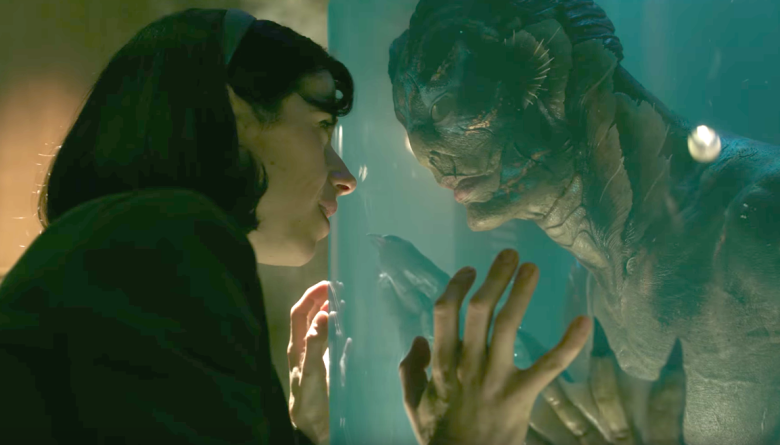Guillermo Del Toro’s 2017 film, The Shape of Water, tells the story of a mute woman, Elisa Esposito (played by Sally Hawkins), who falls in love with and subsequently rescues an amphibian man who was brought into the research facility, which she cleans at night. A band of other characters help her in this rescue, including: her co-worker Zelda Fuller (played by Octavia Spencer), her best friend Giles (played by Richard Jenkins), who is a closeted gay man, and Dr. Robert Hoffstetler (played by Michael Stuhlbarg) who’s actually a Russian spy but goes against his own mission to help Elisa. All the while, Elisa’s boss Richard Strickland (played by Michael Shannon), is on a hunt to find the amphibian man. By the end of the film, Strickland finds Elisa and the amphibian man, shoots them both, but gets knocked out by Giles. The amphibian man then jumps into a pier with Elisa and begins to heal her (he has magic healing powers and eats cats, interesting dude). The “scars” on Elisa’s neck are actually gills, and she regains consciousness before embracing the amphibian man underwater.
Del Toro uses lighting and attire to his advantage in order to differentiate the characters. Elisa begins to wear a red headband (she is eventually dressed entirely in red), representative of her excitement surrounding her flourishing relationship with the amphibian man once she has rescued him from the science facility. This isn’t the only time apparel is used to communicate the nature of the characters in the film: both Zelda and Elisa are part of the nightly cleaning crew and thus wear uniforms of a muted, gray and blue color scheme. Dr. Robert Hoffstetler (the secret Russian spy) has the mission of preventing the Americans from learning anything about the amphibian man, but decides to help Elisa run away with the amphibian man instead. Dr. Hoffstetler’s superiors then visit him at his home to interrogate him and ask what he had done with the subject, where they catch him with his pants down, literally. The antagonists of the characters in the film are usually shown as wearing tight, professional clothing, as to emphasize their demeanor and power, whereas the protagonists wear work uniforms and loose clothing. From the very beginning of the film, Elisa is constantly juxtaposed with water; her morning routine involves boiling eggs and spending some very personal time in the bath. Being that she is part of the nightly cleaning crew, she is usually working with a mop and a bucket. Additionally, the lighting associated with each of the characters varies depending on which character is in the shot. Strickland and the Russians are usually placed in harsh lighting locations while Elisa and the others are placed by windows and dark rooms, accentuating the soft lighting. Del Toro brilliantly and blatantly uses lighting and attire in order to communicate a change in character as well as to serve as a reflection of the narrative.
Although I would have preferred if Elisa’s juxtaposition with water was more difficult to pinpoint in order for the ending to be more of a surprise, I understand that it goes hand in hand with the playful nature of some of the other elements of the film. Sally Hawkins’ performance is like no other, and landed her a Golden Globe nomination for Best Actress in a Drama Motion Picture. If you get a chance to watch this film, keep an ear out for the refreshing and Golden Globe winning score by Alexandre Desplat. Although he has a long history of fantasy films (his bread and butter genre), Guillermo Del Toro really hit it out of the park with this story. The film is beautifully written and executed, and although it is not my personal pick, I do think The Shape of Water will win the Oscar for Best Picture.

Be First to Comment